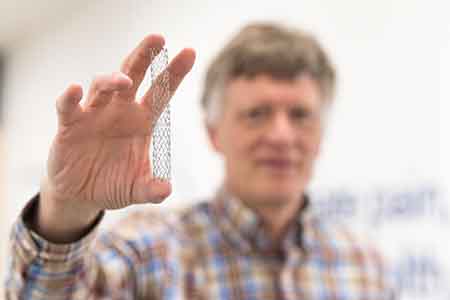People behind our pipeline: Meet Jeff Vogel
Jeff Vogel taught college engineering courses 30 years ago, and never dreamed he'd become an inventor like those he lectured on
Jeff Vogel was in the operating room in 2017 when the first patient received the venous stent he engineered.
“It was a very emotional time,” said Vogel, a senior distinguished engineer in the Peripheral Vascular Health Operating Unit, who devoted years of his life to creating the product, called the Abre™ venous self-expanding stent system.
The surgery was also a pivotal moment for patients with vein obstruction, which affects more than 190 million people worldwide and can cause debilitating symptoms for decades. While stent therapies that propped open arteries for blood flow to the heart were common at the time, stents for veins were not — and the innovation was needed.
“This is making a huge difference in a lot of peoples’ lives,” he said.

The sweet spot
Like many engineering endeavors, Abre was born from a problem.
Physicians needed something better to address vein obstruction, which occurs when a blockage keeps blood from leaving the legs and can cause serious symptoms like edema, leg pain, skin changes, or, in advanced cases, skin ulcers.
Doctors experimented with solutions — and got creative using other types of stents to help patients. While those solutions worked, they had shortcomings as these types of stents were made for arteries not veins.
Vogel and his colleagues collaborated with physicians to understand the patient need — and got to work.
“To be able to partner with the physicians and the engineers at the same time, is really satisfying,” said Vogel. “That is the sweet spot of where we’re making a difference in the world.”
Solutions, reimagined
The research and development process for the appropriately named Abre, (coined by the engineering team, it means “open” in Spanish), required a lot of imagination.
“We have generally avoided putting stents where there’s a lot of movement in the body,” Vogel said. “But to put it right across the joint? We just didn’t do that.”

Since vein obstruction often extends from the pelvis into the leg — crossing a high-movement area of the body — Medtronic engineers needed to design a stent that bends without kinking and compresses without breaking.
The undertaking required new lasers, partnering with manufacturers, and finding suppliers to provide raw material. Vogel said he personally read more than 1,000 abstracts and hundreds of papers to understand the scope of the need.
The finished product looks a lot like a finger trap toy. It’s made from laser-cut nitinol, and self-expands to open veins and improve blood flow.
“We pushed those experiments harder and in all those measures of strength and flexibility, we went further,” Vogel said on how his team pushed the design of Abre to new heights in strengths and flexibility in ways competitors didn’t.
‘Making a difference’
Vogel, who grew up in northern Minnesota and began his engineering career by teaching the subject, now advises Medtronic engineers who are exploring what healthcare technology to create next. He brings physicians’ perspectives into Medtronic engineering labs.
He also continues to work closely with doctors — especially those who switch from treating hearts to veins — and understands the impact venous stenting can have on a patient’s quality of life.
“When they treat some hearts, they might get a thank you note, maybe not,” he said. “But when they treat veins, these patients are hugging and kissing them, sending them Christmas cards. They get their lives back in such a big way. We’re making a difference.”
Intended Use/Indications: The Abre™ venous self-expanding stent system (Abre™ stent system) is indicated for use in the iliofemoral veins for the treatment of symptomatic venous outflow obstruction.
Contraindications: Do not use the Abre™ stent system with patients with known hypersensitivity to nickel titanium (nitinol), with patients who are judged to have a lesion that prevents complete inflation of a balloon dilatation catheter or proper placement of the stent or the stent delivery system, and with patients in whom anticoagulant or antiplatelet therapy is contraindicated.
Potential Adverse Effects of the Device on Health: The potential adverse effects (e.g., complications) associated with the use of the Abre™ stent system include, but are not limited to, access failure, access site infection, allergic reaction to contrast medium or procedure medications; aneurysm; AV fistula; bleeding; bruising; death; device breakage; device maldeployment; edema; embolization; fever; hematoma; hypertension; hypotension, nausea, or other vasovagal response; infection; myocardial infarction, arrhythmia, or other cardiovascular insufficiency; open surgical repair; pain; pseudoaneurysm; renal insufficiency or renal failure (new or worsening); respiratory distress or pulmonary embolism; sepsis; stent fracture; stent malapposition; stent malposition; stent migration; stroke, paradoxical embolism, transient ischemic attack, or intracerebral hemorrhage; tissue necrosis; venous occlusion, restenosis, or thrombosis, within or outside of stented segment; and vessel damage, including intimal injury, dissection, perforation, or rupture.
Warnings, precautions, and instructions for use can be found in the product labeling at http://manuals.medtronic.com.
CAUTION: Federal (USA) law restricts this device to sale by or on the order of a physician.
L001-06122023
Related content



